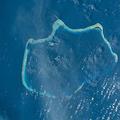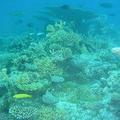 新的研究顯示,經過50多年前的核子試爆浩劫原子爆炸浩劫,位於太平洋馬紹爾群島的比基尼環礁珊瑚,又開始繁茂起來了;然而,潛水人員也發現有些地區性珊瑚礁種類可能也絕滅了。
新的研究顯示,經過50多年前的核子試爆浩劫原子爆炸浩劫,位於太平洋馬紹爾群島的比基尼環礁珊瑚,又開始繁茂起來了;然而,潛水人員也發現有些地區性珊瑚礁種類可能也絕滅了。
這項珊瑚調查是應比基尼環礁地方政府的要求而進行的。一個來自澳洲、德國、義大利、夏威夷及馬紹爾群島的國際科學家團隊檢查了環礁周圍的海洋生物多樣性及數量,他們潛到「喝采彈坑(Bravo Crater)」,也就是1954年爆炸威力最大的美國原子彈所留下來的巨大坑洞。這個比二次世界大戰末期投到廣島(Hiroshima)的原子彈強1000倍的氫彈,威力相當於1500萬噸的黃色炸藥(TNT)。
這個「喝采」氫彈(Bravo bomb)將當地3座島嶼化為烏有,把附近水域溫度升高至55000℃,震撼了200公里外的馬紹爾群島,並留下一個2公里寬73公尺深的大坑洞。
澳洲研究委員會(ARC,Australian Research Council)珊瑚礁研究卓越中心(Centre of Excellence for Coral Reef Studies)及詹姆士庫克大學(James Cook University)的芮查斯(Zoe Richards)表示:「我當時不知道要期待什麼,可能是某種月球表面吧!然而它的狀況卻是令人無法置信的,大片高達8公尺高枝枒分歧的微孔珊瑚(Porites coral)已經建立起來了,創造了繁茂的珊瑚礁棲地。我很驚喜其他各處環礁淺水瀉湖的珊瑚礁覆蓋率高達80%,而且珊瑚礁已形成樹狀分枝以及30公分厚的枝幹」。她指出:「這真是太好了!我從來沒見過馬紹爾群島外面有珊瑚長成樹叢狀。」
 儘管如此,研究團隊還是記錄到環礁裡損失很高程度的珊瑚種類。與原子彈測試之前一個著名的研究相比較,研究團隊發現相較於1950年代初期,42種珊瑚已經消失了。
儘管如此,研究團隊還是記錄到環礁裡損失很高程度的珊瑚種類。與原子彈測試之前一個著名的研究相比較,研究團隊發現相較於1950年代初期,42種珊瑚已經消失了。
這些消失的種類中,有28種的區域消失狀況看起來像是單純地因該地從1946至1958年23次爆炸或是爆炸導致的輻射活動、營養成分升高以及被微細沈積物悶死。
芮查斯解釋說:「這些消失的珊瑚都是脆弱的淺水瀉湖特有種類,纖細的分枝或是葉狀的型態都是淺水瀉湖受遮蔽水域僅見的種類。」雖然大多數珊瑚都蠻有韌性的,但是芮查斯表示,比基尼環礁的珊瑚多樣性已經被證明不能完全抵抗當地事件所產生的干擾。
Fifty years after the last atomic blast shook the Pacific atoll of Bikini, the corals are flourishing again, new research shows, although divers found that some coral species appear to be locally extinct.
The coral survey was carried out at the request of the atoll's local government.
An international team of scientists from Australia, Germany, Italy, Hawaii and the Marshall Islands examined the diversity and abundance of marine life around the atoll.
They dove into the vast Bravo Crater left in 1954 by the most powerful American atom bomb ever exploded. At 15 megatonnes of TNT it was 1,000 times more powerful than the bomb dropped on Hiroshima that ended World War II.
The Bravo bomb vaporized three islands, raised water temperatures to 55,000 degrees, shook islands 200 kilometers away and left a crater two kilometers wide and 73 meters deep.
"I didn't know what to expect - some kind of moonscape perhaps," said Zoe Richards of the ARC Centre of Excellence for Coral Reef Studies and James Cook University. "But it was incredible, huge matrices of branching Porites coral up to eight meters high had established, creating thriving coral reef habitat."
"Throughout other parts of the lagoon it was awesome to see coral cover as high as 80 percent and large tree-like branching coral formations with trunks 30cm thick," she said. "It was fascinating - I've never seen corals growing like trees outside of the Marshall Islands."
But the team documented a high level of loss of coral species from the atoll. Compared with a famous study made before the atomic tests were carried out, the team established that 42 species were missing compared to the early 1950s.
At least 28 of these species losses appear to be genuine local extinctions probably due to the 23 bombs that were exploded there from 1946 to 1958, or the resulting radioactivity, increased nutrient levels and smothering from fine sediments.
"The missing corals are fragile lagoonal specialists, slender branching or leafy forms that you only find in the sheltered waters of a lagoon,” Richards explains.
While corals in general have shown resilience, she says the coral biodiversity at Bikini Atoll has proven only partially resilient to the disturbances that have occurred there.
全文及圖片詳見:ENS






